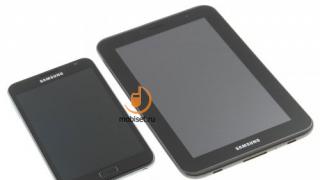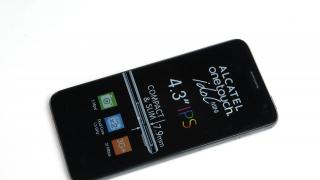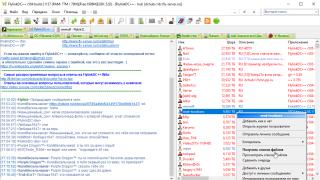Personal computer as a system
One of the objects, considered in computer science lessons, is a personal computer. It can be considered as a system consisting of subsystems "hardware", "software", "information resources"(fig. 1.20).

The hardware subsystem acts as a supersystem for input, processing, storage and output devices.
Operating system- software subsystem and supersystem, which includes system and service programs.
Information resource system includes systems of text and image files, sound files, video information files, etc.

Personal Computer is part of the "human-computer" system. The means that provide the relationship between the objects of this system are called the interface. Distinguish between hardware, software, hardware-software and user interfaces.
Hardware interface- interaction between computer devices; provided by the manufacturers of this equipment.
Programming interface- interaction (compatibility) of programs with each other, as well as software and information resources; provided by software developers.
Hardware-software and user interface provided by the operating system of the computer.
Hardware-software interface- interaction of hardware and software of the computer.
User interface- human-computer interaction. The menu-based user interface offers the ability to select a control command from a menu (command list). In a graphical interface, computer objects are represented by small pictures (icons). The desired icon is selected with the mouse. In addition to icons, texts (for prompts) and menus (for selecting commands) are also used. The 3D interface allows navigation in 3D computer space. By pointing the mouse at the door of the virtual museum, you can enter it. In the virtual room, you can look around, approach any picture and examine it in more detail. This is how the real world interfaces.
Briefly about the main thing
Personal Computer- a system including subsystems of hardware, software and information resources.
Personal Computer- subsystem of the "man - computer" system. The means that provide the relationship between the objects of this system are called the interface.
User interface- human-computer interaction. It is provided by the operating system.
Questions and tasks
1. What systems include the "computer" subsystem? For which systems is the computer a supersystem?
2. Name the super-system for the "printer" object. What is the relationship between the printer and inkjet objects?
3. What is an interface? List the types of interface.
4. What do you know about user interface?
5. How do you understand the meaning of the phrase: "The Windows operating system provides the same user interface when working with different objects"?
6. Have inputs and outputs for the computer system.
Test work No. 1
on the topic "Objects and Systems"
Part A
A1. Complete the sentence: "Any part of the surrounding reality, perceived by a person as a whole, is called ..."
1.concept
2.the object
3.the subject
4.system
A2. Note the single object names:
1.machine
2.birch
3.Moscow
4. Baikal
5. Pushkin A.S.
6.operating system
7. keyboard simulator
8. Windows XP
A3. Mark the operating system objects:
1.Desktop
2.window
3.folder
4.file
5.computer
A4. Note the signs that may be indicated in the message about the object:
1.Properties
2.sizes
3.behavior
4.condition
5.Actions
A5. Specify the relationship for the pair "processor and system unit":
1.is an element of the set
2.included in
3.is a variety
4.is the reason
A6. Note natural systems:
1. Solar system
2.football team
3.plant
4.computer
5.car
6.math language
A7. Specify the subsystems included in the "Personal computer hardware" system:
1.input devices
2. storage devices
3.operating system
4.applied programs
Part B
1. Fill in the table with the following words: thunder, PC work, floppy drive, monitor, lightning, drawing, printer, text printing.

2. Give the most accurate common name for each group of objects
a) Cuba, Haiti, Chile, Peru
b) Nile, Congo, Danube, Rhine
c) Joystick, scanner, mouse, keyboard, light pen.
3. For the properties of each of the objects below, specify the name (value) and value

4. Make a diagram of the varieties:
Printer, optical, laser, inkjet, monitor, matrix, raster, liquid crystal (LCD), mouse, ballpoint, PC devices.
AVL vs Red-Black. Red and black property. Estimation of heights. Insert d. An example of a double right turn. A height-balanced binary tree. Analysis. An example of a red-black tree. AVL trees. Let's remove f. Turns. Visual demonstration. Estimating the height of the tree. New node. Red and black tree. Left child node. Balancing on removal. The height of some subtree. Container. Insert f. Vertices.
"Remote control system" - Gate mechanism. Sources of obstacles. Marquis. Mode. Radio control. Connection diagram. Lighting for summer cottages. Gate drive mechanism. Transmitters. Radius of action. Distance. Remote control. Creation of light scenes. Receivers for surface installation. Usage example. Signal obstruction. Management of awnings. Idea. Minimum distance. Receivers. Remote control systems.
"Computer terms" - Information. Device. Windows registry. Computer accessories. Link on the Internet. Operating system. Online alias. Avatar. Recordable CD-ROM drive. Flash drive. Clicking a mouse button. Banner. Virus program. Start browsing. The local network. Dictionary of computer terms. Motherboard. Windows. Sound. Spam.
"Programming principle of computer operation" - Software imitation. Implementation. Compiled languages. Computer components. Situation. Translators. Sequence control. The state of the computer. Organization of a traditional computer. Compilation. Constant representation. Assignment operator. Broadcast time. Hardware and software computer. Virtual computers. Language implementation time. Impact of machine architecture. Binding.
"Searching for information in the computer" - Masks of file names. Sequential search. Examples of information processing processes. Road map. What are your possible actions. Practical work "Information search". Automated information processing. Which relates to search attributes. Communication types. Information search and management. Search for information. Management teams. Find out the author and title of the play. What is a self-governing system. Block search.
"School computer" - System unit. The language of Hell. Disk. A computer without a program. Display. Scanner. Poem. Smart TV. School computer. Ch. Babbage's analytical engine. First printer. Keyboard. How information gets into the computer. Prophetic words. Computer. Ada Augusta Lovelace. The first electronic computers. CPU.
ROUTING LESSON DESIGN
Thing :Informatics
Class
Lesson topic :
Personal computer as a system
The purpose of the lesson:
1) expand and generalize the ideas of schoolchildren about systems of objects;
2) to give an idea of the personal computer as a system;
3) master new techniques for creating graphic objects.
Lesson type:
Lesson in learning new material
Means to achieve the goal:
The use of technologies for the development of critical thinking in the lesson, the use of active notes to navigate the actions of students
Planned results :
Subject
Metasubject
Personal
Students will learn to:
Introduce about a personal computer as a system, supersystems and PC subsystems;
name the main devices of a personal computer and their current characteristics;
Analyze surrounding objects from the point of view of a systematic approach;
Understand the purpose of the main devices of a personal computer;
Understand the role of the computer in the life of a modern person,
Understand the implications of computer skills for study and life;
Understand the need to use a systems approach in life.
Lesson problem:
Learners have difficulty in
The main idea of the lesson:
Basic concepts studied in the lesson
System, super-system, interface.
The type of ICT tools used in the lesson
PC, multimedia projector, multimedia presentation
Educational Internet Resources
ORGANIZATIONAL STRUCTURE OF THE LESSON
1. STAGE - CHALLENGE The main tasks of the stage:
1. Updating existing knowledge, methods of action;
2. Awakening interest in receiving new information;
3. Setting the student's own learning goals
Teacher activity
1. Introductory speech of the teacher
1. Since this topic completes the section "Objects and Systems", at the beginning of the lesson, test work is carried out for 5-7 minutes.
2. Work on the formulation of the problem of the lesson.
Questions:
1. P List the main components of your computer.
2. What additional (peripheral) devices can I connect to my computer?
3. What data can be processed using a computer and what is needed for this?
4. What is the systemic effect when the PC is running?
Conclusion:
A computer is a complex object consisting of many devices, it requires programs to work, so it can be considered ------
Hence the topic of our lesson:
What are the objectives of the lesson:
Discover
Learn to
Understand
Students' activities
1. Pupils take the test, check, give points
2. Formulation of the lesson problem:
Pupils answer the teacher's questions:
1. System unit, monitor, keyboard, mouse, processor and memory;
2. Printer, camcorder, projector, scanner and other devices;
3. You can process numerical, graphic, text and multimedia data using programs;
4. Each detail or program separately does not have the property that the entire "personal computer" system has, namely, to work and process information.
As a system;
Lesson topic “ Personal computer as a system "
Students formulate goals:
- how the "personal computer" system works
- define supersystems and subsystems of the PC
- what is an interface and what are its types.
2. STAGE Problem Explanation of New Knowledge
stage task: Active work with various sources of information: active notes, with a textbook, Internet materials, aimed at solving the problem of the lesson.
Teacher activity
How a personal computer functions as a system, let us find out what in the PC serves as a supersystem and what as a subsystem.
Chat with the textbook. Find out what an interface is and what its types are. Complete the exercise.
Run the task on the computer:
Students' activities
Video
Read the textbook on p. 40-41, perform № 71 , explain the completion of the task, check their answers with the correct template for filling out the scheme, give points.
Etc. No. 5 Task No. 6
3. STAGE Reflection
The stage of reflection (reflection) allows students to consolidate new knowledge and rebuild their primary idea of the material being studied. Thus, there is a holistic understanding and "appropriation" of new knowledge, the formation of their own attitude to the studied material.
Teacher activity
Was it easy or difficult for you?
What did you do best and without mistakes?
What was the most interesting task and why?
Did you manage to achieve the goals that you set for yourself at the beginning of the lesson?
How would you rate your work?
Questions to consolidate.
What devices are included in the system unit?
What processor specifications do you know?
What is clock speed?
What is processor bitness?
What is the difference between RAM and external memory.
Why are hard drives called "hard drives"?
Grade - average score for all tasks in the lesson
Students' activities
4. STAGE Homework. Textbook: §6 RT: No. 69, 73
One of the objects considered in computer science lessons is a personal computer. It can be considered as a system consisting of subsystems "hardware", "software", "information resources" (Fig. 1.20).
Rice. 1.20
The hardware subsystem acts as a supersystem for input, processing, storage and output devices.
Operating system is a software subsystem and a supersystem, which includes system and service programs.
The information resource system includes systems of text and graphic files, sound files, files with video information, etc.
The personal computer is a part of the "human-computer" system. The means that provide the relationship between the objects of this system are called the interface. Distinguish between hardware, software, hardware-software and user interfaces.
Hardware interface - interaction between computer devices; provided by the manufacturers of this equipment.
Programming interface - interaction (compatibility) of programs with each other, as well as software and information resources; provided by software developers.
The hardware-software and user interface are provided by the computer's operating system.
Hardware-software interface - the interaction of hardware and software of a computer.
User interface - Human-computer interaction. The menu-based user interface offers the ability to select a control command from a menu (command list). In a graphical interface, computer objects are represented by small pictures (icons). The desired icon is selected with the mouse. In addition to icons, texts (for prompts) and menus (for selecting commands) are also used. The 3D interface allows navigation in 3D computer space. By pointing the mouse at the door of the virtual museum, you can enter it. In the virtual room, you can look around, approach any picture and examine it in more detail. This interface simulates the real world.
Briefly about the main thing
Personal computer - a system that includes subsystems of hardware, software and information resources.
Personal computer is a subsystem of the "man - computer" system. The means that provide the relationship between the objects of this system are called the interface.
User interface - Human-computer interaction. It is provided by the operating system.
Questions and tasks
- What systems include the "computer" subsystem? For which systems is the computer a supersystem?
- Name the super-system for the "printer" object. What is the relationship between the printer and inkjet objects?
- What is an interface? List the types of interface.
- What do you know about user interface?
- How do you understand the meaning of the phrase: "The Windows operating system provides the same user interface when working with different objects"?
- Specify the inputs and outputs for the computer system.
Lesson number 7. In grade 7
Topic: “Personal computer as a system. Objects and Systems "
Goals:
Educational:
to consolidate the ideas of schoolchildren about systems of objects;
give an idea of the pc as a system;
test knowledge on the subject of "objects and systems"
Developing:
develop logical thinking, memory, attention, the ability to compare and analyze, the ability
apply the acquired knowledge and skills when performing practical exercises;
Educational:
to form a set of universal educational actions that provide the ability to learn, i.e.
process information;
to form the information culture of schoolchildren;
to form a deeper understanding of object systems and their features;
to form ideological positions;
Equipment:
computer,
board
projector
Software
presentation
multimedia projector, computer
Lesson type:
explanatory-demonstration
During the classes
Organizing time
Checking those present at the lesson, preparing students for the lesson.
Homework check
Tutorial: §1.7.
Workbook: visual check of assignments: p. 25-26 No. 41.42
Repetition of past material
Writing the concept of "Black box"
Give an example of the interaction between the system and the environment. Specify inputs and outputs
systems.
Learning new material
One of the objects that we are considering in computer science lessons is a PC, so today we will consider a PC as a system.
Let's remember: the system is a whole, consisting of parts, interconnected with each other. The parts that make up the system are called its elements, i.e. A PC consists of certain parts, with the help of which it can perform some actions, namely, to work with information in a quality manner.
If we look at the PC system, then we can distinguish 3 subsystems in it: hardware, software, information resources. OS is the most important program of a PC.
Application programs - creating images, texts, videos.
Development software - development of other programs that will fulfill our requirements.
The PC is a part of the "Human - PC" system, in order for a person to work normally at the PC, to be able to understand it, there must be means that ensure the relationship between the objects of the system - this is an object - a person, an object - a PC.The means that ensure the relationship between man and computer is an interface.
The interface can be divided into 4 groups.
If the PC showed us the information that it sees itself, i.e. 101000, we would not understand anything. Due to the fact that there are wasps that convert 101100 to the form we are used to, we can work normally on a PC.
Generalization of the new material PC - system - including subsystems of hardware, software and information resources.
PC is a subsystem of the "man - computer" system.
The means that provide the relationship between the objects of this system are called the interface.
User interface is human-computer interaction.
Securing new material
Workbook: p. 35 No. 48
Test
Evaluation criteria:
1-3 –(0-49%) - 2
4 – (50-70%) - 3
5 - (71-85%) - 4
6-7 - (86 – 100%) – 5
Part 2:
Test 1
Option 1.
1. Complete the sentence: "Any part of the surrounding reality, perceived by a person as a whole, is called ..."
the notion
object
subject
system
2. Note the single object names:
car
Birch
Moscow
Baikal
Pushkin A.S.
operating system
keyboard simulator
Windows XP
3. Mark the objects of the operating system:
Desktop
window
folder
file
computer
properties
dimensions
behavior
condition
actions
5. Specify the relationship for the pair "processor and system unit":
is part of the set
is part of
is a kind
is the reason
6. Note natural systems:
solar system
football team
plant
computer
automobile
mathematical language
7. Specify the subsystems included in the "Personal computer hardware" system:
input devices
operating system
application programs
Option 2.
Complete the sentence: "A whole, consisting of parts interconnected with each other, is called ..."
the notion
object
subject
system
2. Note the common object names:
car
Birch
Moscow
Baikal
Pushkin A.S.
operating system
keyboard simulator
Windows XP
3. Check the classroom objects:
Desktop
window
folder
file
computer
4. Check the signs that may be indicated in the message about the object:
properties
behavior
condition
opportunities
actions
5. Specify the relationship for the "graphic editor and MS Paint" pair:
is part of the set
is part of
is a kind
is the reason
6. Check technical systems:
solar system
football team
plant
computer
automobile
mathematical language
7. Specify the subsystems included in the "Personal computer software" system:
input devices
storage devices
operating system
application programs
Lesson summary
Report grades to students, summarize the lesson.
Homework Textbook: Read §1.8. Workbook: p.36 No. 50



